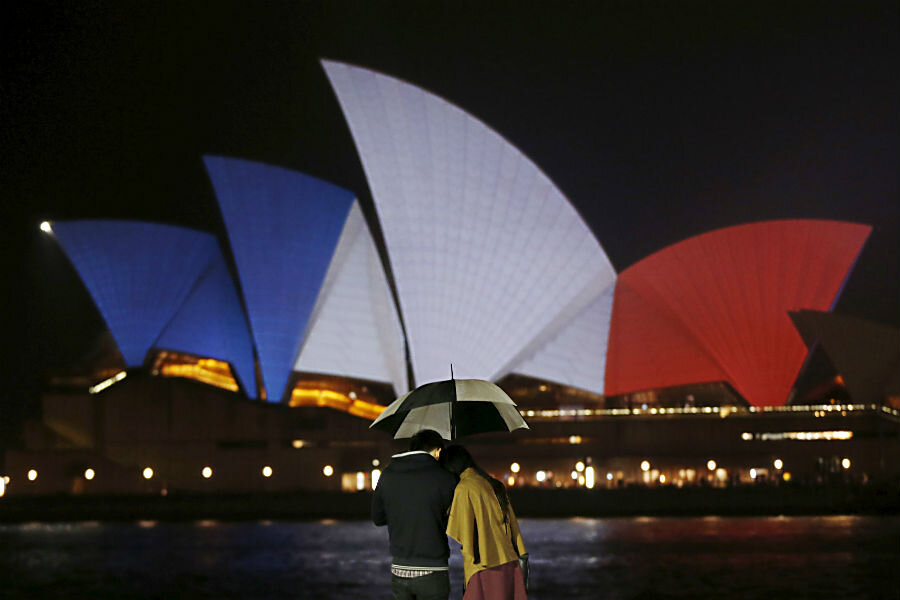Solidarity in symbols: World responds with light to Paris attacks
Loading...
Just an hour after a series of attacks rocked Paris on Friday night, the Eiffel Tower went dark in mourning.
But the response worldwide was to turn on the light: Three colors began appearing in solidarity: blue, white, and red.
Cities around the United States were blanketed with France’s tricolors. In New York, One World Trade Center and the Empire State building became vertical canvases for the France’s national flag. Emotions ran high in New York in remembrance of 9/11 – many left flowers, candles, and even a glass of wine and a baguette. In Washington, a Capitals hockey game turned the ice rink into the French flag. Flowers piled up outside French consulates in Dallas, Boston, New York, Chicago, Los Angeles and San Francisco, among others.
“We are reminded in this time of tragedy that the bonds of liberté and égalité and fraternité are not only values that the French people care so deeply about, but they are values that we share." said President Obama.
As is often the case after such terror attacks, people want to show defiance, empathy, and unity. Indeed, in hours after the attack, many iconic monuments worldwide lit up in solidarity: Sydney’s Opera House, Berlin's Brandenburg Gate, Rio de Janiero’s famous Christ the Redeemer statue, and London’s Wembley Stadium.
Some of those who gathered around the statue in Brazil Saturday carried signs stating, "Rio is Paris."
Other forms of empathy and support have gone viral on social media, including a simple drawing of the Eiffel Tower embedded in a peace sign created by the London-based French graphic artist Jean Jullien that saw over 45,000 shares in less than 10 hours.
Within hours, Facebook generated a blue, white and red “French filter.” Twitter users followed the hashtag #PorteOuverte (“Open Door”) to help shelter those still stuck on the streets of Paris in the hours after the attack. Other trending hashtags included #prayforparis, #StandWithParis, #parisattacks, and #MuslimsAreNotTerrorists.
Many found hospitality and shelter as Paris went on lockdown last night, including some 20 customers who spent the night in the famous Shakespeare & Company bookstore.
Authorities are increasing police patrols in major cities in response to the attacks, although police authorities in the US do not claim to know of any immediate threats.
“Whenever these attacks happen, we’ve always counted on the French people to stand with us. We intend to be there with them in that same fashion,” said Mr. Obama in a press statement on Friday.
The death toll in Paris has climbed to 127 confirmed fatalities, with as many as 80 people still in critical condition and nearly 300 wounded. People lined up outside hospitals in Paris Saturday to donate blood in what was one of the deadliest massacres in France since World War II.
Often in the wake of attacks of this magnitude, activity on social media accounts blossoms, offering a temporary, if not remedial sense of solidarity. But immediately after the attacks, Facebook activated its "Safety Check" feature for users in and around Paris. First introduced in 2014, the tool enables survivors of natural disasters or other mass tragedies to quickly and easily tell their Facebook friends that they’re OK. For the same purpose, Google announced Hangout calls to France from any country would be free.
And more concrete steps are emerging. Prayer vigils were held outside French embassies in Europe, and others were planned Saturday in cities around the US.
The French Red Cross has mobilized over 300 volunteers to bring relief to victims – and the Red Cross is collecting donations. Proceeds will go to the International Federation of Red Cross and will support their efforts. Other groups like Medicins Sans Frontieres and Secours populair francaise – a nonprofit dedicated to fighting against poverty and exclusion – are also accepting donations.






